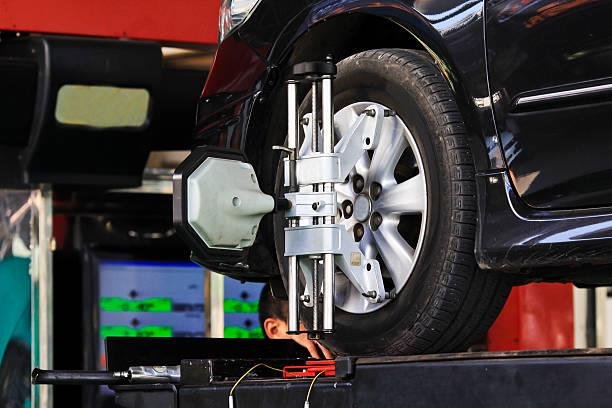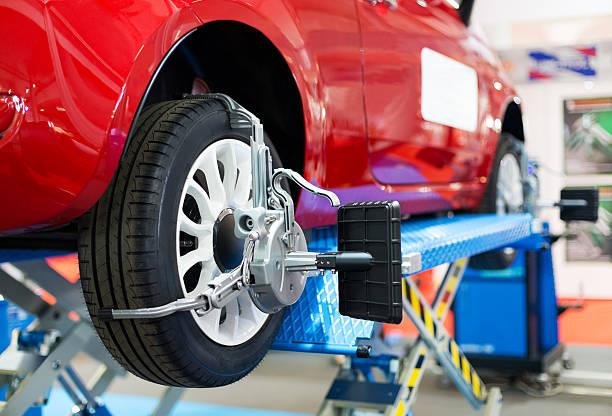Proper wheel alignment is a critical aspect of vehicle maintenance that often goes overlooked by drivers. However, neglecting wheel alignment can lead to a host of issues, including uneven tyre wear, poor handling, decreased fuel efficiency, and compromised safety. Wheel alignment services play a crucial role in maintaining the integrity of your vehicle’s suspension system and ensuring a smooth, safe, and efficient driving experience. In this comprehensive guide, we’ll delve into the importance of wheel alignment services, the signs that indicate your vehicle may need alignment, the benefits of regular alignment checks, and the process involved in wheel alignment services.
Table of Contents
Understanding Wheel Alignment
Wheel alignment, also known as tyre alignment, refers to the adjustment of the angles of the wheels relative to each other and the vehicle’s body. Proper wheel alignment service with Fulcrum Suspensions ensures that all four wheels are parallel to each other and perpendicular to the ground, maximizing tyre contact with the road surface and minimizing rolling resistance. There are three primary angles that technicians measure during wheel alignment:
- Camber: The angle of the wheel relative to the vertical axis when viewed from the front or rear of the vehicle. Positive camber occurs when the top of the wheel tilts outward, while negative camber occurs when the top of the wheel tilts inward.
- Toe: The angle of the wheels relative to the centerline of the vehicle when viewed from above. Toe-in occurs when the front edges of the wheels are closer together than the rear edges, while toe-out occurs when the front edges are farther apart.
- Caster: The angle of the steering axis when viewed from the side of the vehicle. Positive caster occurs when the steering axis tilts toward the rear of the vehicle, while negative caster occurs when it tilts toward the front.
Signs Your Vehicle Needs Wheel Alignment
- Uneven Tyre Wear: Excessive or uneven tyre wear, such as feathering or cupping, is often a telltale sign of improper wheel alignment. Misaligned wheels can cause tyres to wear unevenly, leading to premature tyre replacement and reduced tyre lifespan.
- Vehicle Pulling or Drifting: If your vehicle pulls to one side or drifts while driving on a straight road, it may be a sign of misaligned wheels. Uneven camber or toe angles can cause the vehicle to veer off course, requiring constant steering corrections to maintain a straight trajectory.
- Steering Wheel Off-Center: A crooked or off-center steering wheel when driving straight is indicative of wheel misalignment. This occurs when the toe angle is not symmetrical, causing the steering wheel to point in the direction of the misalignment.
- Vibration or Shimmying: Vibrations or shimmying felt through the steering wheel or vehicle chassis, especially at higher speeds, may indicate wheel misalignment or imbalanced tyres. Misaligned wheels can cause uneven tyre contact with the road, leading to vibrations and instability.
- Decreased Fuel Efficiency: Improper wheel alignment can increase rolling resistance, causing the vehicle’s engine to work harder and consume more fuel. By maintaining proper alignment, you can maximize fuel efficiency and reduce fuel costs over time.
Benefits of Regular Wheel Alignment Checks
- Extended Tyre Life: Proper wheel alignment ensures even tyre wear, maximizing the lifespan of your tyres and reducing the frequency of tire replacements. By maintaining proper alignment, you can save money on tyre expenses in the long run.
- Improved Handling and Stability: Properly aligned wheels provide optimal contact with the road surface, enhancing vehicle handling, steering response, and overall stability. This improves driving dynamics and reduces the risk of loss of control, especially during emergency manoeuvres.
- Enhanced Safety: Misaligned wheels can compromise vehicle stability and handling, increasing the risk of accidents and collisions. By regularly checking and correcting wheel alignment, you can ensure safer driving conditions for yourself, your passengers, and other road users.
- Maximized Fuel Efficiency: Proper wheel alignment reduces rolling resistance and friction between the tyres and the road surface, improving fuel efficiency and reducing fuel consumption. This translates to cost savings at the pump and reduced environmental impact.
- Optimal Suspension Performance: Wheel alignment is closely tied to the health and performance of the vehicle’s suspension system. Proper alignment ensures that suspension components operate smoothly and efficiently, minimizing wear and tear and prolonging their lifespan.
The Wheel Alignment Process
- Initial Assessment: A qualified technician begins the wheel alignment process by conducting an initial assessment of the vehicle’s suspension system and tyre condition. This may include visual inspections, tyre tread depth measurements, and checking for signs of uneven tyre wear.
- Alignment Measurements: Using specialized alignment equipment, the technician measures the camber, toe, and caster angles of each wheel to determine the extent of misalignment. These measurements are compared to the manufacturer’s specifications to identify deviations that require correction.
- Adjustment Procedures: Based on the alignment measurements, the technician makes adjustments to the vehicle’s suspension components to bring the wheels back into proper alignment. This may involve adjusting camber, toe, and caster angles using specialized tools and equipment.
- Final Verification: Once adjustments are made, the technician performs a final verification of the wheel alignment to ensure that all angles fall within the manufacturer’s specifications. This may involve test-driving the vehicle and rechecking alignment measurements to confirm proper alignment.
- Documentation and Recommendations: The technician provides documentation of the alignment measurements and adjustments made during the process. They may also offer recommendations for future maintenance and alignment checks to ensure ongoing performance and safety.
Conclusion
Wheel alignment services are essential for maintaining the integrity of your vehicle’s suspension system, optimizing tyre performance, and ensuring a smooth, safe, and efficient driving experience. By understanding the importance of proper wheel alignment, recognizing the signs of misalignment, and prioritizing regular alignment checks, you can prolong the lifespan of your tyres, enhance vehicle handling and stability, and maximize fuel efficiency. Whether you’re due for routine maintenance or experiencing symptoms of misalignment, scheduling wheel alignment services with a trusted automotive professional is a proactive step toward preserving your vehicle’s performance and safety on the road. So why wait? Invest in wheel alignment services today and enjoy the benefits of a smoother ride and improved vehicle performance for miles to come.











